Related Research Articles

Guanyin, Guan Yin or Kuan Yin is the most commonly used Chinese translation of the bodhisattva known as Avalokiteśvara. Guanyin is the Buddhist bodhisattva associated with compassion. In the East Asian world, Guanyin is the equivalent term for Avalokitesvara Bodhisattva. Guanyin also refers to the bodhisattva as adopted by other Eastern religions. She was first given the appellation of "goddess of Mercy" or the Mercy goddess by Jesuit missionaries in China. The Chinese name Guanyin is short for Guanshiyin, which means "[The One Who] Perceives the Sounds of the World." On the 19th day of the 6th lunar month, Guan Shi Yin's attainment of Buddhahood is celebrated.

The Ardhanarishvara is a composite form of the Hindu deities Shiva and Parvati. Ardhanarishvara is depicted as half-male and half-female, equally split down the middle. The right half is usually the male Shiva, illustrating his traditional attributes.
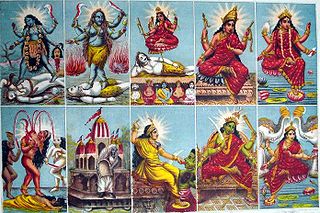
The Mahavidya are a group of ten aspects of Adi Parashakti in Hinduism. The 10 Mahavidyas are Kali, Tara, Tripura Sundari (Shodoshi), Bhuvaneshvari, Tripura Bhairavi, Chhinnamasta, Dhumavati, Bagalamukhi, Matangi and Kamala.

Dhumavati is one of the Mahavidyas, a group of ten Tantric goddesses. Dhumavati represents the fearsome aspect of Devi, the Hindu Divine Mother. She is often portrayed as an old, ugly widow, and is associated with things considered inauspicious and unattractive in Hinduism, such as the crow and the Chaturmas period. The goddess is often depicted on a horseless chariot or riding a crow, usually in a cremation ground.

In Buddhism, Avalokiteśvara has 108 avatars. One of these avatars is called Padmapani, the one who holds the lotus (padma). Avalokiteshvara is the bodhisattva who embodies the compassion of all Buddhas. This bodhisattva is variably depicted, described and portrayed in different cultures as either male or female. In Tibet, he is known as Chenrezig. In China, Taiwan and other Chinese communities, Avalokiteśvara has evolved into the somewhat different female figure Guanyin or Guanshiyin, also known as Kannon or Kanzeon in Japan,Gwanseum in Korea and Quan Am in Vietnamese. In Nepal Mandal, this figure is known as Jana Baha Dyah, Karunamaya or Seto Machindranath. He is known as Natha Deviyo in Sri Lanka and Lokanatha In Myanmar(Burma). In Thailand and Cambodia, he is called as Lokesvara.

Matangi is a Hindu goddess. She is one of the Mahavidyas, ten Tantric goddesses and an aspect of Devi, the Hindu Divine Mother. She is considered to be the Tantric form of Sarasvati, the goddess of music and learning. Like Sarasvati, Matangi governs speech, music, knowledge and the arts. Her worship is prescribed to acquire supernatural powers, especially gaining control over enemies, attracting people to oneself, acquiring mastery over the arts and gaining supreme knowledge.

Tara, Ārya Tārā, or Shayama Tara, also known as Jetsun Dölma is an important figure in Buddhism, especially revered in Tibetan Buddhism. She appears as a female bodhisattva in Mahayana Buddhism, and as a female Buddha in Vajrayana Buddhism. She is known as the "mother of liberation", and represents the virtues of success in work and achievements. She is known as Duōluó Púsà (多羅菩薩) in Chinese Buddhism, and as Tara Bosatsu (多羅菩薩) in Japan.
Super Machine Zambot 3 is a Super Robot anime series created by Yoshiyuki Tomino and Yoshitake Suzuki, featuring character design by Yoshikazu Yasuhiko and produced by Sunrise. It was first broadcast on Japanese TV in 1977. The series lasted for 23 episodes.

Class of the Titans is a Canadian animated television series produced by Studio B Productions and Nelvana Limited. It premiered on December 31, 2005 at 5 pm ET/PT on Teletoon with a special 90-minute presentation of the first three episodes. The series aired in the United States on Qubo from September 19, 2009 to October 24, 2009. On April 1, 2012, the series returned to Qubo as part of its Qubo Night Owl block replacing "Spliced" where it remained until July 25, 2020.

Katyayani (कात्यायनी) is one of the avtars of The Hindu Mother Goddess, Durga. She is seen as the slayer of the tyrannical demon Mahishasura. She is also the sixth form amongst Navadurga or the nine forms of Hindu goddess Durga (Parvati), worshipped during the Navratri celebrations. She may be depicted with four, ten, or eighteen hands. This is the second name given for Goddess Adi Parashakti in Amarakosha, the Sanskrit lexicon. Goddess Katyayani was worshipped by Sita, Radha and Rukmini for a good husband.
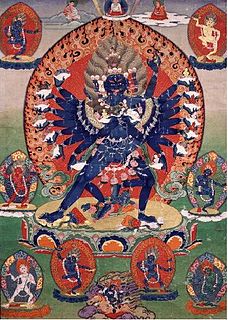
Hevajra is one of the main yidams in Tantric, or Vajrayana Buddhism. Hevajra's consort is Nairātmyā.

Vasudhārā, whose name means "stream of gems" in Sanskrit, is the Buddhist bodhisattva of wealth, prosperity, and abundance. She is popular in many Buddhist countries and is a subject in Buddhist legends and art. Originally an Indian bodhisattva, her popularity has spread to southern Buddhist countries. Her popularity, however, peaks in Nepal where she has a strong following among the Buddhist Newars of the Kathmandu Valley and is thus a central figure in Newar Buddhism. She is named Shiskar Apa in Lahul and Spiti. She is comparable to the Earth goddesses Phra Mae Thorani in Theravada and Tai folk religion and Bhūmidevī and Pṛthvī in Hinduism.
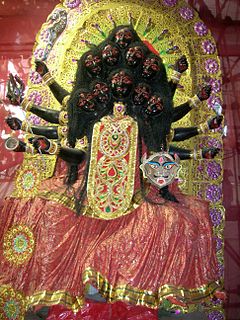
Mahakali, is the much revered Hindu Goddess of destruction and doomsday. Mahakali is fiercest of the Goddesses of universal power, time, life, death and both rebirth and liberation. She devours Kala (Time) and then resumes her own dark formlessness. She is also the consort of Mahakala a form of Lord Shiva, the god of consciousness, the basis of reality and existence. Mahakali in Sanskrit is etymologically the feminized variant of Mahakala or Great Time, an epithet of the god Shiva in Hinduism. Parvati and all her forms are the different manifestations of Mahakali.
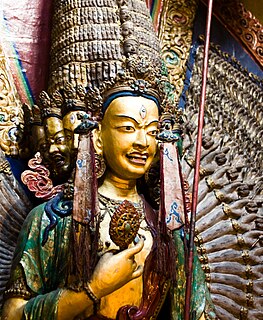
Sitātapatrā is a protector against supernatural danger in Buddhism. She is venerated in both the Mahayana and Vajrayana traditions. She is also known as Uṣṇīṣa Sitātapatrā. It is believed that Sitātapatrā is a powerful independent deity emanated by Gautama Buddha from his uṣṇīṣa. Whoever practices her mantra will be reborn in Amitābha's pure land of Sukhāvatī as well as gaining protection against supernatural danger and witchcraft.

Kali, also known as Kalika, is a Hindu goddess. Kali is the chief of the Mahavidyas, a group of ten Tantric goddesses who each form a different aspect of the mother goddess Parvati.
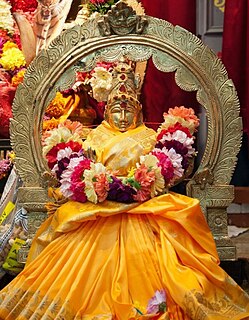
Bhuvaneshvari is the fourth amongst the ten Mahavidya goddesses in Hinduism, and an aspect of Parvati as elements of the physical cosmos in giving shape to the creation of the World.

Vināyakī is an elephant-headed Hindu goddess. Her historical and iconography are not clearly defined. Little is told about her in Hindu scriptures and very few images of this deity exist.
Vishvarupa ("Universal-form"), also known popularly as Vishvarupa Darshan, Vishwaroopa and Virata rupa, is an iconographical form and theophany of the Hindu god Vishnu or his avatar Krishna. Though there are multiple Vishvarupa theophanies, the most celebrated is in the Bhagavad Gita, "the song of God", given by Krishna in the epic Mahabharata, which was told to Pandava Prince Arjuna on the battlefield of Kurukshetra in the war in the Mahabharata between the Pandavas and Kauravas. Vishvarupa is considered the supreme form of Vishnu, where the whole Multiverse is described as contained in him.

In the Shakta tradition of Hinduism, Manidvipa/Manidweepa is the eternal supreme abode of the goddess Lalita Tripurasundari/ Bhuvaneshvari Devi Mula Prakritithe supreme being in Shaktism. Also known as Sripura, Śrī Nagara and Devi Loka, it is an island situated in the middle of an ocean called the Sudhā Samudra. In the Devi Bhagavatam, Manidvipa is portrayed as the Sarvaloka, the highest world, superior to Kailasa, realm of Shiva, Vaikuntha, realm of Vishnu, and Goloka, realm of Krishna. This is consistent with the Devi Bhagavatam's portrayal of Goddess Bhuvaneswari Devi as higher than any of these other gods. In her form as Bhuvaneshvari or Tripurasundari, Devi is the Empress of Manidvipa. At the beginning of the creation, Supreme Goddess, in her form Tripurasundari, created this island according to her will.
References
- 1 2 Philadelphia Museum of Art. Ushnishasitatapattra, She Who Shelters with the White Parasol. Retrieved on August 23, 2015.